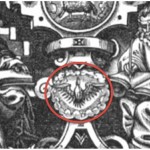Pelicans are funny looking birds. They have long thick bills with a pouch for catching fish beneath. As they dive for fish, they thrust their heads into the water at the last minute to catch their prey before their whole body follows it with an awkward crash into the sea. On the other hand, nothing is more magnificent than a flight of pelicans skimming together in close-packed formation inches above the waves with their fantastic wings barely moving. They are a familiar bird to most Southern Californians but did you know they were also an early symbol of Christianity?

Most people know the cross is a Christian symbol. Some know the same is true of the simple fish, but starting in the second century, the pelican also became a Christian symbol. They are common in stained glass windows and carved into massive cathedral doors. There is a line in the 12th century hymn “Humbly we adore thee” that describes Christ as the “loving pelican divine.” Queen Elizabeth of England chose the pelican as her symbol and at the top of the title page of the very first King James Bible (1611) there is an etching of a pelican feeding her young. (See the illustration.)
We can understand the symbol of the cross – that’s where Jesus died. We understand the symbol of the lamb, since the gentle, sacrificial lamb often represents Christ in the Bible. What about the fish? The letters from the Greek word for fish (ichthus) represent the first letters of the phrase “Jesus Christ God’s Son and Savior,” but how did the pelican come to symbolize Christianity?
For the answer to that question we need to visit Alexandria, Egypt in the Second Century. A Christian author penned a book of morals for children. In it he described various animals, birds, plants and even stones. He would describe one of these and then its special attributes and encourage children to imitate them. The book is called the Physiology. It’s still available. (Although originally written in Greek, it’s been translated into Latin, Syriac, English and a host of other languages. See Amazon.com.) It’s richly decorated and was very, very popular.
So how does this relate to the pelican becoming a symbol of Christianity? Have you ever watched a pelican at rest? Her beak often lays on her breast and they characteristically rub it up and down. The Mediterranean pelican’s pouch is blood red during mating season. Thus the legend was born that a mother pelican, in times of famine, will pierce her breast and heroically feed her children on her own blood. As a result, the pelican came to symbolize the sacrifice of Jesus who gave his blood that we might live.
